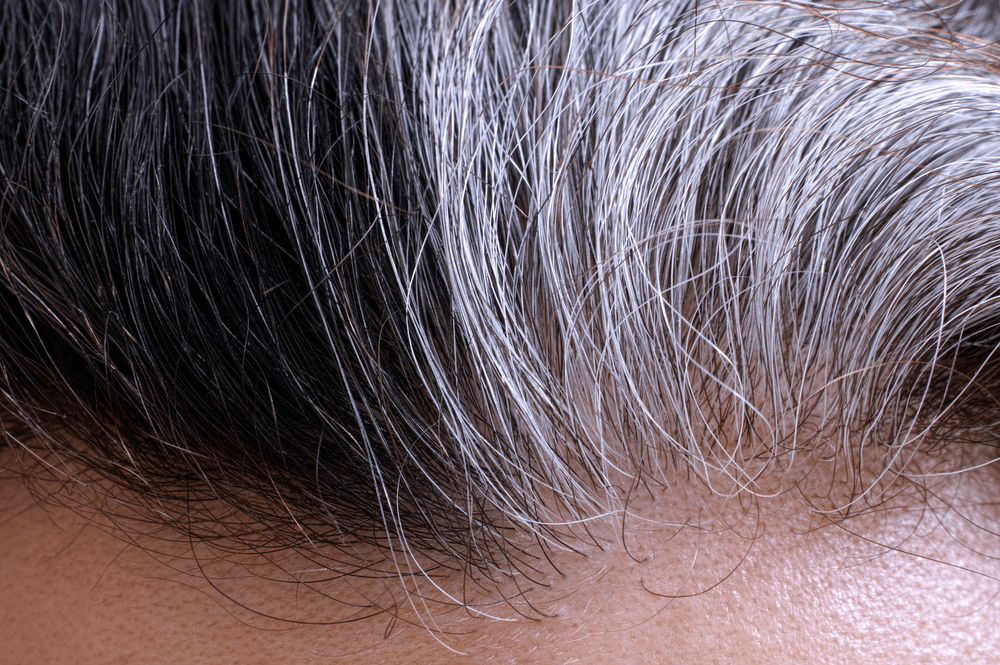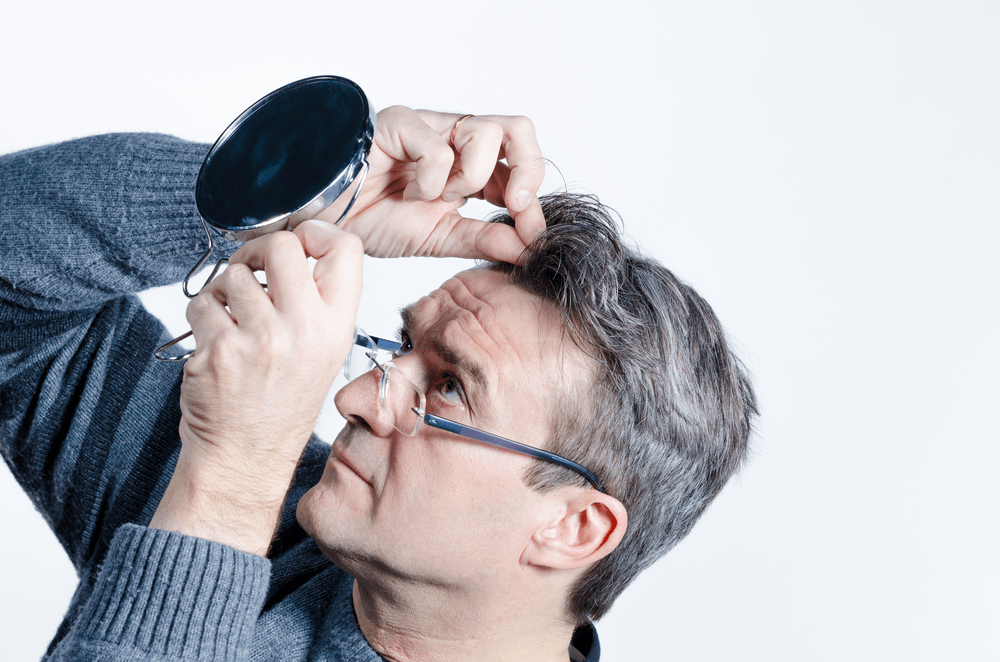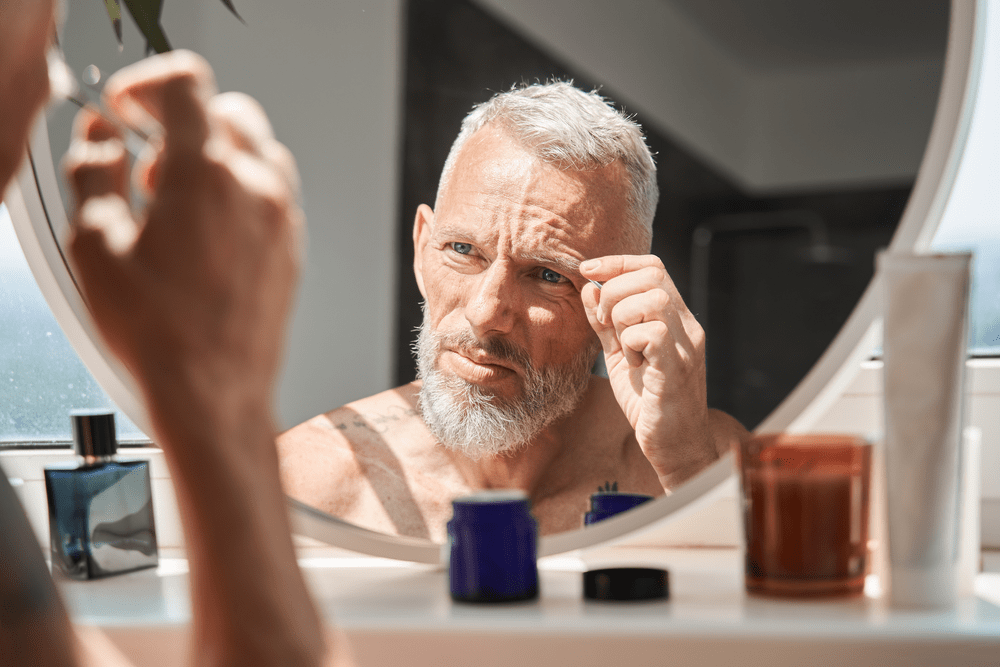Wondering just why does hair turn gray–especially prematurely? Below, we delve into what causes those gray hairs as you get older–and why it could happen earlier than you think.
View in gallery

There are a lot of things you expect as you grow older – increased wisdom from life experiences, a growing arsenal of increasingly potent dad jokes, and the not-so-great phenomenon of graying hair! It’s just the way of life.
Related Reading: Should You Dye Your Beard?
But why does hair turn gray exactly? And why is it that some people’s hair never turns gray while others start getting gray or white hairs in their 20s? Can you prevent it? Is there a cure? What should you do the moment you start seeing those dreaded grays in your hair?
Without further ado, let’s get down to the bottom, or rather, the roots of your graying hair!
The Structure of Your Hair
Before we can look at the concept of gray hair, we should first fully understand the structure of your hair.
A single strand of hair is made up of two central parts.
- Hair Roots
- Hair Shafts
The root is the base part of your hair and is embedded in your scalp, hidden away inside the hair follicle. It is these follicles that determine if you have red, blonde, black or brown hair. More on this in a bit.
The hair shafts are the colored strand of hair that we see on our heads. It is the hair strands that betray us so readily as we age and turn from such luxurious shares to the colorless gray we all dread.
Related Reading: Understanding Your Maturing Hairline
How Does Hair Color Work?
View in gallery

Before looking at the causes of this change to your hair, it’s important to understand how hair gets its color or pigment in the first place.
- The hair gets its color from the melanocyte stem cells. These stem cells are found in different parts of the human body and produce a natural pigment called melanin. Melanin in your hair follicles is responsible for your hair color, and the melanin in your skin is responsible for your skin color.
- Melanin has two main types – pheomelanin and eumelanin. What types and how much of it is in your hair follicles determine your hair’s natural color. It can be black, light or dark brown, blond, red, or something in between.
- Natural color may change as people age. Light-colored hair can turn several shares darker and dark-colored hair can turn a few shades lighter. The matter of graying hair is then an entirely separate discussion.
Although each person is different, the melanocyte stem cells in the hair follicle usually start making less melanin as you get older. And once those stem cells stop making pigment, that’s when your hair turns gray.
Fun Fact: A study claims that by 50 years old, up to 23% of the people already have up to 50% gray hair. And that is irrespective of their hair color or sex.
Myths about Why Hair Turns Gray
View in gallery
It’s perfectly normal that hair turns gray as we get older. Whether you like it or not, it will happen to the majority (if not all) of us at some point.
But before that, let’s first look at some myths about gray hair.
- MYTH: Bleaching your hair will cause gray hair.
- MYTH: Regularly coloring your hair will also lead to gray hair.
- MYTH: Plucking gray hair will cause means more gray hair grows back.
- MYTH: You can get rid of gray hairs by laser hair removal.
But as common as these myths about hair growth are, they are simply not true.
Related Reading: Best Biotin Shampoo for Hair Growth
When Does Hair Turn Gray? Ethnicity Makes a Difference
View in gallery

Graying hair is an inescapable part of aging, but it’s not a one-way process. The first few white hairs can appear in different people at different ages. And ethnicity plays a major role in how early or late you can expect your hair to turn gray.
Here are the typical ages when hair turns white and when it could be considered premature graying.
- Caucasians: Greying tends to start in mid 30s, with premature graying as soon as early 20s.
- Asians: Greying tends to start in late 30s, with premature graying as soon as mid 20s.
- Africans: Greying tends to start much later in mid 40s, with greying before 30 considered premature.
Premature color loss is also largely associated with genetics. So, if your parents started struggling with faulty melanocyte stem cells at an earlier age, chances are you will, too.
External Factors of Grey Hair at an Early Age
View in gallery

Going gray, by itself, doesn’t mean that you’re nearly at the end of your lifespan. Although it is one of the signs of aging, the color of your hair depends on more than just age.
Without delving too far into matters of cell biology, we can review a few different factors that can bring the salt and pepper to the table.
Lifestyle Matters
While graying is usually a normal aging process tempered by hereditary traits, your lifestyle plays a major role when the graying process happens. Both environmental and nutritional factors can negatively impact hair growth and lead to the emergence of the dreaded grays.
For instance, the wrong diet can jumpstart graying. Low iron, copper, and zinc can speed up hair graying. The same goes if you are deficient in the following nutrients:
- Vitamin B12 (poultry, eggs, fish, milk)
- Protein (fish, nuts, poultry, dairy)
Do you smoke? Or perhaps, you’re often exposed to secondhand smoke. Both are lifestyle habits that may cause premature graying of hair. Excessive alcohol consumption is another unhealthy lifestyle choice that you might need to kick if you want to prevent impeding healthy hair growth and color loss.
Stress Is Involved
Stress is another possible cause why your hair might be turning silver early, although indirectly. There’s oxidative stress and exposure to real-life stressors such as a stressful job. It’s long been documented that stress can have a negative impact on your immune system, so it’s not a big jump to understand how it can also cause permanent damage to your hair.
Oxidative Stress
This cellular process happens because of damage caused to hair stem cells due to excess free radicals in the body. For instance, a build-up of a naturally produced chemical in the body called hydrogen peroxide in the hair shaft is a major cause of oxidative stress in pigment cells and hair follicles. Eventually, damaged hair follicles lose pigment, causing graying. Other factors that contribute to oxidative stress are UV rays, pollution, and inflammation.
Real-Life Stressors
There’s still a debate whether stress can cause gray roots at a young age. But a New York University study finds that pigment-producing stem cells that are responsible for hair color get depleted when the body is under stress.
Whatever kind of stress it is (could be like being overworked on your job), it could lead to a fight or flight response, activating your nervous system. When that happens, it can damage your pigment cells.
And once your melanocyte stem cells are gone, they will be gone for good. The loss of these pigment producing cells strips the natural colors of your hair. This means your hair grows through gray as time goes by.
Health Can Be a Deciding Factor
Some health problems, particularly such as a weak immune system or even autoimmune diseases, may increase your risk of getting gray or white hair earlier in life, such as:
- Vitiligo
- Dysfunction in the pituitary or thyroid gland
- An autoimmune skin condition called Alopecia areata
Can You Reverse Gray Hair?
People have been trying to understand and solve the puzzle of why hair turns grey for decades. And until recently, it has been a firm ‘no’ when it comes to the question of whether gray hair is irreversible or not.
It may be possible to reverse the hair graying process, according to a recent study, although it might only be temporary. Removing stress that causes hairs to turn gray will restore some of the pigment in some parts of the hair.
It suggests that addressing deficiencies (like taking necessary vitamin supplements) and changing to a healthier lifestyle can possibly reverse gray hair.
Unfortunately, it doesn’t include the graying phenomenon due to aging. So, in short, more studies have to be made to learn if the emergence of gray hair, in general, is a truly reversible process.
Solving the Puzzle of Gray Hair
View in gallery

Finding that first silvery strand can be shocking – but a perfectly natural reaction! However, it’s not exactly the end of the world. While it’s important to stay as healthy as possible to at least prevent premature hair graying, remember that it’s perfectly normal.
Once you get out of the initial panic mode, it’s time to tackle that colorless hair. So, what do you do to combat the inevitable slowdown of your melanocyte stem cells?
To Pluck or Not to Pluck?
Plucking could be the first thing you might consider the moment you spot your first gray or white hair. But there’s a good reason not to do that. And it’s not the old wives’ tale that believes plucking a gray hair will cause three more to grow back in its place.
So, why resist the temptation of plucking your gray hair?
There’s only one reason – plucking adds more stress and damage to the individual hair follicle. It might not make three more gray hairs grow, but it could leave that spot bald over time. And that’s because a damaged hair follicle can cause hair not to grow back in that same spot.
To Dye or Not to Dye?
They say that your hair is supposed to be your crowning glory. But when that crown starts going gray, you now face a crucial decision – to dye or not to dye? That is the question.
Whether you choose to go all-natural and let those silver strands grow out or cover them up is entirely based on your preference.
But if you do consider dyeing your hair, make sure to pick the right product.
Some tips to think about:
- Consider highlights. It’s a good option for blondes since the odd gray hair will be less obvious. Dyeing you’re your hair ash blond, for instance, requires less upkeep as your hair grows as there won’t be conspicuous roots or yellow cast to worry about.
- Use semi/demi-permanent hair color for 30-70% gray coverage. It’s suitable for all gray hair types but most effective for covering the first grays. It will keep your natural hair color while tinting the few silver strands you have.
- Use permanent hair color. It is the best option for complete coverage if you have 50% gray hair or more. This type of product contains ammonia that allows the color to penetrate deeper into your hair. It will provide a more lasting cover for white hair.
How to Own Your Gray Hair like a Silver Fox
View in gallery

Just because your hair is turning gray doesn’t mean you have to dye or cover it. Gray hair gets a bad rep, but like any reputation, it can be changed!
Losing the color from your hair doesn’t mean it’s less of a crowning glory compared to blondes, redheads, and brunettes out there. You can still let your hair down and flaunt your silvery mane.
How? Take some inspiration from these celebrities who chose to rock the grays, natural color or otherwise, like it’s nobody’s business.
- Richard Gere
- Diane Keaton
- Hugh Grant
- Meryl Streep
- Barack Obama
- Jamie Lee Curtis
- George Clooney
- Blythe Danner
- Denzel Washington
- Pink
Just because your hair follicles don’t seem to regenerate pigments anymore, you do not need to fret. Embracing your new hair is a great way to show your melanin producing cells that you will not be held back by something as silly as a color change.
Why Does Hair Turn Gray: The Bottom Line
In most cases, gray or white hair growth is a part of the aging process. It’s completely normal. But different people may start seeing their hair grows gray at different ages. That could be because of different factors: race, underlying health conditions, and lifestyle factors.
At what age did you go gray? Whatever the reason for your lowered pigment production, when it comes down to it, your hair still needs the same amount of care irrespective of the color. So, are you ready to rock salt and pepper hair? Don’t hesitate to share your thoughts in the comments below.
Maybe you have your own theory about why hair turns gray. Perhaps you have some funny stories of gray coverups gone wrong? We love to hear from you, so don’t be shy.





All my life I had sandy blonde hair. When I was 40 years old, I was working nights, and seldom saw the sun. At this age, I shaved my head, and my hair grew back dark brown. I’m 68 now, my beard, which was always very dark brown, is mostly gray, but the hair in my head is dark brown, with no gray hair at all. As for stress, due to a back injury and several failed surgeries, I’ve suffered from chronic severe back pain, which is extremely stressful, since I was 41. The stress created by that obviously hasn’t caused graying.